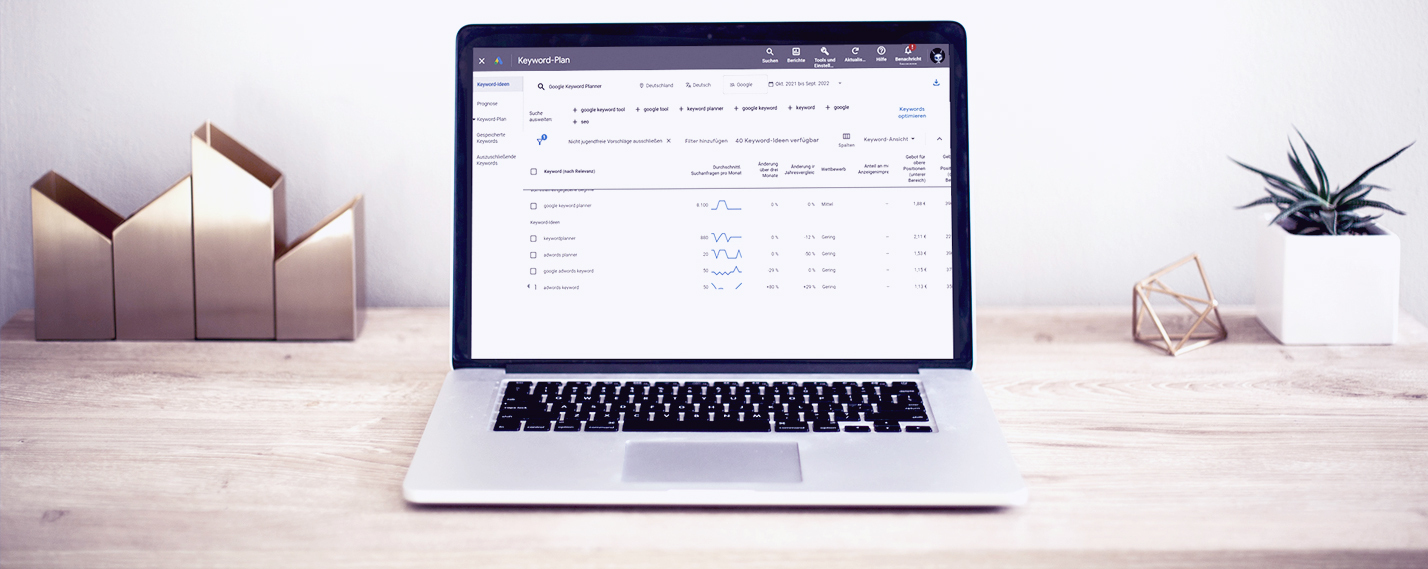Advertisers in Google Ads are often faced with the question of which is the right Google Ads bid strategy for their campaigns. Therefore, we would like to take a closer look at this topic in this blog post to make your daily campaign life easier.
Definition: What are bid strategies?
Bid strategies are settings adapted to campaign types that help you achieve a result for a desired amount. Google gives you the option of choosing between automated (smart bidding) and manual bid strategies.
Automated vs manual bid strategies
In Google Ads, we are basically dealing with two overriding different types of strategies. These are the automated strategies on the one hand and the manual strategies on the other.
The automated strategies include
- Target ROAS
- Target CPA
- Maximize clicks
- Maximize conversions
- Maximize conversion value
- Target Search Page Location
- Outranking Share
- Auto-optimised CPC
- Target Impression Share
Automated bid strategies
Automated bid strategies are strategies where the automatically defined bids for your ads are based on the chance that this ad will actually lead to a click or a conversion.
Manual bid strategy
The manual bid strategy (manual CPC) still offers the most cost control. You yourself decide how much a click may cost at most. In addition, there are tools such as the bid simulator that support you in setting your bids. With a manual strategy, however, you should be aware that although you have full cost control, this can mean an enormous manual effort. Regular adjustments of the click prices and consideration of external influences such as the competitive situation and demand are on the agenda.
The auto-optimised CPC is a combination of manual and automated strategy. Here, manually defined bids are automatically adjusted by Google depending on the probability of a conversion. If Google classifies the conversion probability as high, the bids are adjusted upwards accordingly. If the probability is low, the bids are adjusted downwards.
The goals of the automated bid strategies
First, let’s take a closer look at automated bid strategies. If you decide to use an automated bid strategy, the first question is “What is your goal? Google basically distinguishes between 4 different goals and recommends the following bid strategies at the same time:
Increase sales ⇒ maximize conversion value or target ROAS
Increase leads ⇒ maximize conversions or target CPA
Increase number of website visitors => maximize clicks
Increase or maintain awareness ⇒ Target Impression Share
In principle, it is advisable to follow these recommendations in the first instance. However, each case or campaign should be considered and evaluated individually.
Rentability targets vs. budget targets
Bid strategies can also be subdivided according to performance focus. The primary question here is: Should performance / output be optimised according to a predefined target or according to a predefined budget. Thus, profitability targets vs budget targets are opposed to each other:
Rentability targets (target ROAS & target CPA)
Focus: Maximizing performance according to a predefined target
Target ROAS: Return on Advertising Spend describes the average value in percent of how many euros a campaign has generated for each euro invested. In practice, this means that you define a target value or average value in advance (e.g. 500%). The algorithm then tries to optimise the performance to this value or to achieve 5 times the turnover of your budget.
Target CPA (Cost per Acquisition): The focus of this strategy is primarily based on the central question of at what point a prospect is a new customer or how much you are willing to pay per lead or conversion. If, for example, you define a target CPA value of 50 euros, you will try to make an acquisition cost an average of 50 euros.
We have also written an extra blog post on the topic of ROAS vs. CPA. Feel free to have a look if you want to know more about it.
Budget targets (maximisation strategies)
Focus: Maximizing performance according to a predefined budget
Maximization strategies focus on the utilisation of the given daily budget with the background of maximising the selected metric (impressions, clicks, conversions, conversion values).
Maximization strategies such as “maximize conversion value” or “maximize clicks” are often recommended when you are starting a new campaign and first want to build up traffic or a certain data basis.
Conclusion – Which is the right bid strategy for me?
The choice of the right bid strategy cannot always be answered across the board, as various factors play a role in answering the question. In most cases, the basis is a functioning conversion tracking (for target CPA, target ROAS, maximize conversions and maximize conversion value). If this is not the case, you have to resort to a manual bid strategy or maximize clicks or impressions.
At the beginning, always ask yourself what goal you want to achieve with your campaign. Do you want to achieve more sales? Or do you simply want to have more visitors on your website. In the next step, ask yourself about the focus of your performance. Do you want to optimise your performance according to a predefined goal such as a target ROAS of 500% or do you want to maximize your desired KPIs, e.g. clicks or impressions, based on a predefined budget?
These questions will help you answer the question of the right Google Ads bid strategy so that you can get the best out of your campaigns.
Pro Tip / BiddingLab Best Practice:
| Conversion value tracking exists | ⇒ maximize conversion value or target ROAS |
| Conversion tracking without value | ⇒ maximize conversion or target CPA |
| No tracking existing | ⇒ Maximize clicks if you want to generate more website traffic or maximize impressions if you want to achieve awareness. |
With Google Shopping, we generally recommend the strategy of maximising target ROAS or conversion value to our customers, depending on the initial situation.




